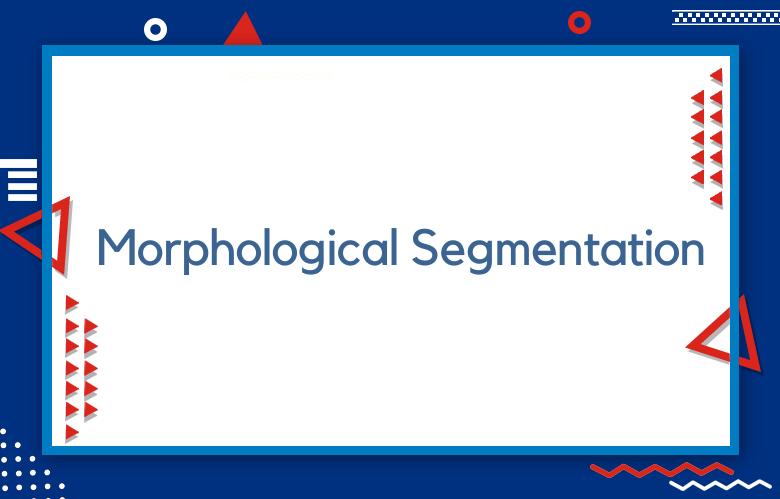What is Morphological Segmentation?

Morphological segmentation is a technique for identifying and analyzing the structure of words in natural language processing tasks. This technique is beneficial in morphologically rich languages such as Arabic and Hebrew, where patterns of prefixes, suffixes, and roots form words. We will explore the importance of Morphological Segmentation in natural language processing algorithms.
Morphological segmentation involves breaking words into their constituent morphemes, which refer to the minor meaningful units in a language.
Morphemes can be prefixes, roots, or suffixes that convey information about a word’s meaning, tense, number, or gender.
For instance, in the Arabic language, the word كتابات means writings, and it consists of three morphemes: the root كتاب (book), the suffix -ات (plurality), and the vowel -ا (case vowel).
Morphological segmentation is essential because it enables computers to understand words’ internal structure and recognize patterns in morphology that indicate word meaning.
How Morphological Segmentation Works?
Morphological segmentation entails breaking down words into morphemes. A morpheme is the smallest unit of meaning in a language that cannot be further broken down.
They can be prefixes, suffixes, or roots. For instance, in the word ‘unbelievable,’ the prefix ‘un,’ the heart ‘believe,’ and the suffix ‘-able’ are morphemes that provide meaning to the word.
Morphological segmentation uses algorithms and rules that teach the computer to segment the word based on the language rules and the available morphemes.
Some algorithms used for morphological segmentation include the maximal likelihood estimation (MLE) algorithm and the maximum entropy Markov model (MEMM).
Importance of Morphological Segmentation?
Morphological segmentation is vital in various NLP tasks, such as text classification, sentiment analysis, and machine translation.
Separating a word into its morphemes makes it easier for language models to process them accurately and identify their meaning.
This, in turn, leads to a more accurate interpretation of the intended message. Morphological segmentation also helps reduce language ambiguity, making it more understandable and easier to process.
Applications of Morphological Segmentation?
Morphological segmentation has several practical applications in everyday life. It is used in search engines to provide more accurate and relevant results, identify misspelled words, and suggest possible alternative search queries.
Morphological segmentation is used in computational linguistics to improve the accuracy of speech recognition and natural language processing systems.
It is also used in creating dictionaries and language learning resources, as it facilitates a more straightforward understanding of word formation in a language.
Morphological Segmentation Techniques?
Depending on the language and desired outcome, various techniques are used for morphological segmentation.
The most common techniques include rule-based analysis, statistical analysis, and hybrid approaches.
The rule-based analysis involves using predefined rules to determine the morphological decomposition of words. Statistical analysis uses machine learning algorithms to analyze patterns in a text corpus and identify common morphemes.
Hybrid approaches combine traditional rules and statistical models to achieve more accurate results.
Understanding Morphological Segmentation: An Overview?
Language is a complex system made up of a variety of components that work together to convey meaning.
One such component is morphology, which deals with how words are formed and the meanings of their parts. Morphological segmentation identifies and segments these significant parts in a comment, also known as morphemes.
This technique is widely used in natural language processing (NLP) to improve machine language understanding and processing. We explore the concept of morphological segmentation, its importance, and its applications in more detail.
Uncovering the Power of Morphological Segmentation in Language Processing
Morphological segmentation plays a crucial role in language processing by breaking down words into meaningful components, or morphemes, to facilitate understanding and analysis. This technique is precious in languages with complex morphology, where words can contain multiple morphemes with distinct meanings. By segmenting words into their constituent morphemes, language processing systems can more accurately interpret and generate text, enabling tasks such as machine translation, speech recognition, and natural language understanding.
Morphological segmentation also aids in tasks like information retrieval and text mining, where understanding the internal structure of words can improve the accuracy and efficiency of analysis. Overall, uncovering the power of morphological segmentation empowers language processing systems to handle complex linguistic structures more effectively, leading to advancements in various areas of artificial intelligence and human-computer interaction.
Mastering Morphological Segmentation Techniques for Improved Text Analysis
Mastering morphological segmentation techniques can significantly enhance text analysis by breaking down words into their morphemes, which are the minor units of meaning. This approach allows for a more granular understanding of text data, particularly in languages with rich morphological structures like English, German, Russian, or Arabic. Here are some essential techniques to consider:
Tokenization: Begin by tokenizing the text into words or morphemes. This involves splitting the text into units based on whitespace or punctuation. However, simple tokenization may not suffice in morphologically rich languages due to complex word forms and derivational morphology.
Stemming: Stemming reduces words to their base or root form by removing prefixes and suffixes. This helps collate variations of the same word to a standard form, improving text analysis tasks such as document retrieval or clustering. Popular stemming algorithms include Porter Stemmer, Snowball Stemmer, and Lancaster Stemmer.
Lemmatization: Lemmatization goes beyond stemming by reducing words to their dictionary form or lemma. This involves considering the word’s morphological context and part-of-speech (POS) information to generate the canonical form. Lemmatization results in more linguistically accurate representations of words, which is beneficial for tasks like natural language understanding and information retrieval.
Morphological Analysis: In languages with rich morphological structures, morphological analysis tools can decompose words into their constituent morphemes. These tools typically rely on morphological dictionaries or finite-state transducers to analyze word forms and identify morphological components such as stems, prefixes, suffixes, and inflectional or derivational affixes.
Part-of-Speech Tagging: Assigning part-of-speech tags to words in a text can provide valuable information about their grammatical roles and syntactic relationships. Part-of-speech tagging can be combined with morphological segmentation techniques to improve accuracy and enable more sophisticated text analysis tasks such as syntactic parsing or named entity recognition.
Morphological Decomposition: Beyond basic stemming or lemmatization, morphological decomposition techniques aim to break down complex words into their constituent morphemes. This involves analyzing word structures and applying morphological rules to identify meaningful components. Morphological decomposition can be particularly useful for languages with agglutinative or fusional morphology.
Compound Splitting: In languages where compound words are prevalent, such as German or Finnish, compound splitting techniques can separate compounds into their parts. This facilitates more accurate analysis of compound words and improves the performance of downstream text processing tasks. Machine Learning Approaches: Machine learning models, such as conditional random fields (CRFs) or recurrent neural networks (RNNs), can be trained to perform morphological segmentation and analysis tasks. These models can learn complex patterns from annotated data and achieve high accuracy in morphological parsing, lemmatization, or part-of-speech tagging tasks.
By mastering these morphological segmentation techniques and incorporating them into text analysis pipelines, researchers and practitioners can unlock deeper insights from text data, improve the performance of natural language processing applications, and enhance the accuracy of text-based machine learning models.
What are the Challenges in Morphological Segmentation?
Although morphological segmentation is essential to NLP, it also presents several challenges.
One significant challenge is the ambiguity that arises from homonyms, words with multiple meanings based on their context.
Another challenge is the complexity of languages with rich morphological systems where words can be compounded, inflected, or agglutininated. This can make developing and applying consistent analysis rules across different languages difficult.
Segmenting Objects in a Scene
One of the primary challenges in morphological segmentation is segmenting objects in a scene.
This can be challenging because a single scene may contain numerous objects, each with varying shapes, sizes, and colors. Other factors may impede certain aspects, making them difficult to segment.
Segmenting Objects in Low-Light Conditions
Another challenge in morphological segmentation is segmenting objects in low-light conditions.
This can be difficult as the contrast between the object and the background may be low, making it challenging to identify the object’s boundaries. Shadows can further complicate the segmentation process.
Segmenting Moving Objects
A further challenge in morphological segmentation is segmenting moving objects. This can be difficult as the objects move quickly, and their boundaries may not be well-defined.
If another object occludes the object, it may not be easy to track its movement.
Identifying Object Boundaries
Another challenge associated with morphological segmentation is identifying object boundaries.
This can be difficult as boundaries may not be well-defined due to occlusion or low contrast between the object and the background.
Some objects may have complex shapes that make it challenging to identify their boundaries.
Determining Object Orientation
Another challenge in morphological segmentation is determining object orientation. This can be difficult as an object’s orientation may change depending on its position in the scene.
Some objects may have symmetrical shapes that make it difficult to determine their orientation.
Classifying Objects
A further challenge in morphological segmentation is classifying objects. This can be difficult as there may be many different classes of objects (e.g., animals, vehicles, buildings), and each type may have various subclasses (e.g., cars, trucks, buses).
Some classes of objects may overlap with others (e.g., a car could also be classified as a vehicle), making classification more difficult.
Morphological Segmentation using AI
Morphological segmentation is a foundational task in artificial intelligence that decomposes complex structures into meaningful parts. It has two primary domains: linguistic morphological segmentation, which breaks words into morphemes (the smallest meaning-bearing units), and computer vision morphological segmentation, which partitions images into regions based on structural properties.
Overview and Significance
Morphological segmentation is an essential preprocessing step in many AI applications. In natural language processing (NLP), it improves understanding of word formation, especially for morphologically rich languages such as Arabic, Finnish, Russian, and Turkish. In computer vision, it supports object recognition, medical imaging, and automated inspection by identifying distinct structural components within images.
Linguistic Morphological Segmentation
Deep Learning Approaches
Neural architectures have transformed morphological segmentation. Transformer-based models, particularly BERT and its variants, perform well in morpheme identification and classification, achieving word-level accuracy rates of 92.5–95.1% for languages such as Czech and Russian.
The transformer architecture’s bidirectional context understanding enables precise boundary detection. For example, a fine-tuned BERT model for Russian can classify characters as PREFIX, ROOT, SUFFIX, or END with 98.52% segmentation accuracy.
BiLSTM-CRF Models
BiLSTM-CRF models combine Bidirectional Long Short-Term Memory networks with Conditional Random Fields, making them effective for sequence labeling tasks. They:
-
Encode contextual information bidirectionally through LSTM layers
-
Model label dependencies with CRF layers for optimal segmentation
-
Deliver robust performance across diverse morphological structures
Studies report F1-scores of 85.73% for word segmentation and 72.65% for part-of-speech tagging in integrated systems.
Attention Mechanisms
Recent research explores attention-free architectures tailored to morphological processing. These systems reduce issues such as character repetition or omission by applying focused encoder states that process input sequences systematically.
Computer Vision Morphological Segmentation
Mathematical Morphology Integration
Morphological segmentation in computer vision often combines mathematical morphology with deep learning. Morphological Neural Networks (MNNs) incorporate operations such as dilation and erosion as differentiable layers within neural models.
Advantages include:
-
Automatic structuring element learning
-
Adaptive selection between dilation and erosion
-
Improved performance in shape-based classification tasks
Hybrid Approaches
Morphological-Convolutional Neural Networks (MCNNs) merge morphological operations with convolutional neural networks, combining geometric insights with deep feature extraction. This integration enhances performance in image-based segmentation tasks.
Foundation Model Applications
Recent work applies foundation models such as the Segment Anything Model (SAM) to morphological segmentation. Through prompt engineering with biologically informed constraints, these models enable:
-
Generalizable segmentation across diverse cellular phenotypes
-
Automated extraction of cellular and subcellular features
-
Effective workflows without retraining requirements
Evaluation and Performance Metrics
Assessing segmentation quality requires metrics that account for morphological complexity. The EMMA (Evaluation Metric for Morphological Analysis) framework uses graph-based assignment algorithms and correlates more strongly with NLP outcomes than traditional boundary-based methods.
Key considerations:
-
Word-level accuracy for complete morphological analysis
-
Boundary precision and recall for segmentation quality
-
Generalization across languages
-
Robustness to unseen morphemes
Applications and Impact
Natural Language Processing
Morphological segmentation supports:
-
Machine Translation: Better performance in morphologically rich languages
-
Information Retrieval: Improved term matching and document relevance
-
Language Education: Automated tools for morphological analysis
Computer Vision
Applications include:
-
Medical Imaging: Cell segmentation and morphological profiling for drug discovery
-
Industrial Inspection: Defect detection in manufacturing
-
Autonomous Systems: Object recognition and scene understanding
Current Challenges and Future Directions
-
Out-of-Vocabulary Handling: Performance declines on words with unseen morphemes. BERT-like models partially mitigate this but require further refinement.
-
Low-Resource Languages: Limited annotated data hinders progress. Transfer learning and multilingual training are promising approaches.
-
Computational Efficiency: Transformer models are resource-intensive. Lightweight variants such as MorphBERT-Tiny offer potential alternatives.
-
Cross-Domain Generalization: Models trained on one domain often underperform on different genres or time periods, requiring more robust architectures.
Conclusion
Morphological segmentation has advanced from rule-based methods to neural architectures capable of handling complex patterns in language and vision. The adoption of transformers, BiLSTM-CRF models, and mathematical morphology principles has significantly improved accuracy and practical application.
Future research will emphasize cross-linguistic generalization, efficiency in resource-constrained settings, and evaluation frameworks that better reflect real-world tasks. Foundation models and multimodal systems are likely to expand the scope and effectiveness of morphological segmentation across diverse AI applications.
Morphological segmentation is a powerful tool for helping computers understand the structure and meaning of words in natural language processing tasks.
By analyzing words’ morpheme structure and patterns, computers can infer word meaning, reduce ambiguity, and process morphologically rich languages more efficiently.
Morphological segmentation is used in various natural language processing tasks and plays a crucial role in improving their accuracy and effectiveness.
As natural language processing continues to evolve, morphological segmentation will remain a fundamental technique for helping computers understand and interpret human language.
Frequently Asked Questions (FAQs) on Morphological Segmentation
What is morphological segmentation?
Morphological segmentation is breaking words into their most minor meaningful units—morphemes—such as prefixes, roots, and suffixes, to reveal a word’s internal structure.
How does it differ from stemming and lemmatization?
-
-
Stemming crudely strips affixes to reach a root form (e.g., “running” → “run”).
-
Lemmatization uses vocabulary and part-of-speech information to return the canonical dictionary form (e.g., “better” → “good”).
-
Morphological segmentation explicitly identifies every morpheme in a word, including inflectional and derivational affixes.
-
Which algorithms are commonly used?
-
Rule-based methods leverage hand-crafted morphological rules or finite-state transducers.
-
Statistical approaches include Maximum Likelihood Estimation (MLE) and unsupervised models like Morfessor.
-
Machine-learning models include Conditional Random Fields (CRFs) or neural sequence taggers (e.g., BiLSTM-CRF).
Why is it essential for morphologically rich languages?
In Arabic, Hebrew, Turkish, or Finnish, words often encode tense, number, gender, case, and more via affixation. Segmenting them enables better handling of sparsity and ambiguity in NLP applications.
What are its main applications?
-
-
Machine Translation: Aligning morphemes across languages
-
Search & Information Retrieval: Matching query and document morphs
-
Text Classification & Sentiment Analysis: Capturing Subtle Morphological Cues
-
Speech Recognition & Synthesis: Modeling pronunciation variants
-
What challenges does it face?
-
Ambiguity: Homographs may segment differently by context.
-
Complex compounds: Handling nested or concatenated morphemes in agglutinative languages.
-
Resource scarcity: Limited morphological lexicons for low-resource languages.
Call: +91 9848321284
Email: [email protected]



